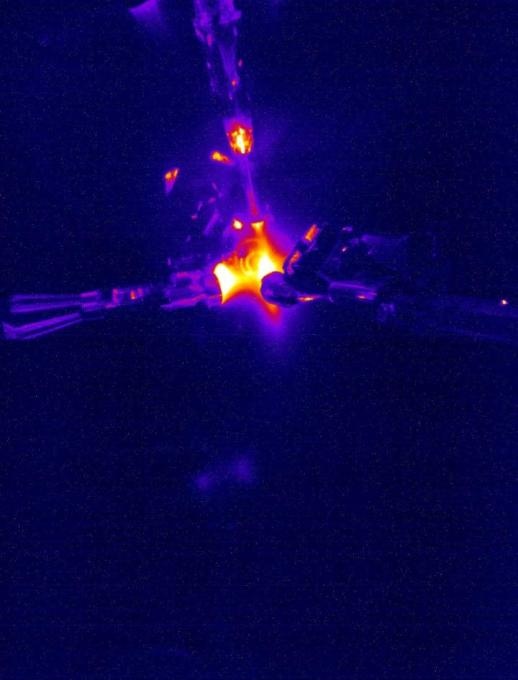Oct 22 2019
Researchers at the National Ignition Facility (NIF), the biggest laser in the world, in Livermore, California, readily produce star-like conditions with 192 high-powered lasers.
 Shot-time image from a NIF experiment to study stellar nucleosynthesis. Solar 3He-3He reactions are happening in the bright center of the image, where the very hot and very dense star-like conditions are created by blasting a small plastic capsule filled with gas at 10 times the atmospheric pressure with 192 high-powered laser beams. Some of the focused laser beams can be seen coming in from the top and left sides of the image. (Image credit: Don Jedlovec, LLNL)
Shot-time image from a NIF experiment to study stellar nucleosynthesis. Solar 3He-3He reactions are happening in the bright center of the image, where the very hot and very dense star-like conditions are created by blasting a small plastic capsule filled with gas at 10 times the atmospheric pressure with 192 high-powered laser beams. Some of the focused laser beams can be seen coming in from the top and left sides of the image. (Image credit: Don Jedlovec, LLNL)
Stars in space are produced by a process known as nucleosynthesis, which combines lower weight atoms to form new heavier atomic nuclei. Natural elements like aluminum and helium that are present on Earth were formed by this mechanism within a star not different from the sun.
The energy from NIF laser beams is increased in a building equivalent to the length of three football fields, and subsequently focused on small gas- or ice-filled capsules with walls of 18 µm thickness (approximately equal to the thickness of a strand of human hair) and 3 mm outer diameters.
The capsule is positioned accurately at the center of a 10-m-diameter target chamber, which is similar to precisely positioning an ant at the exact center of a school bus. Upon blasting the capsules with all 192 laser beams, they collapse and form extremely hot and highly dense star-like conditions.
Current experiments at the NIF will analyze the 3He-3He reaction between two helium ions, one of the main solar nucleosynthesis mechanisms, under star-like conditions. Such a reaction yields about half the production of energy in the sun as it burns hydrogen into helium.
What is so cool about these experiments is that unlike in earlier studies on Earth, we are actually probing this reaction at temperature and density conditions comparable to those found in stars.
Dr Maria Gatu Johnson, Project Lead Scientist, MIT
In the forthcoming meeting of the American Physical Society Division of Plasma Physics in Ft. Lauderdale, Florida, Dr Gatu Johnson will demonstrate how protons from the solar 3He-3He reaction have been identified in these experiments at different conditions.
Surprisingly, the preliminary results show that at lower temperatures, relatively more protons are seen with higher energy than with lower energy.
Dr Maria Gatu Johnson, Project Lead Scientist, MIT
These findings will assist researchers to include significant constraints in the theoretical calculations of this complex reaction and to determine the probability of the occurrence of the 3He-3He reaction, in addition to other crucial mechanisms in the sun.
Further experiments are now scheduled for February 2020, where Dr Gatu Johnson intends to better characterize the temperatures attained under star-like conditions.
Such experiments are part of a new attempt to investigate nucleosynthesis reactions and related phenomena under star-like conditions with lasers.
High-energy-density plasmas are the only laboratory on earth that recreate the extreme conditions in which the elements were produced in the universe.
Dr Alex Zylstra, Study Co-Principal Investigator, Lawrence Livermore National Laboratory
More research will be carried out using this platform to examine other nucleosynthesis reactions and relevant phenomena in the future.
This research was partially supported by the U.S. Department of Energy and the National Nuclear Security Administration (DE-NA0001857, DE-NA0002949, DE-NA0002905, DE-FG02-88ER40387, DE-NA-0001808, and Center-of-Excellence Grant DE-NA0003868).
Source: https://www.aps.org/